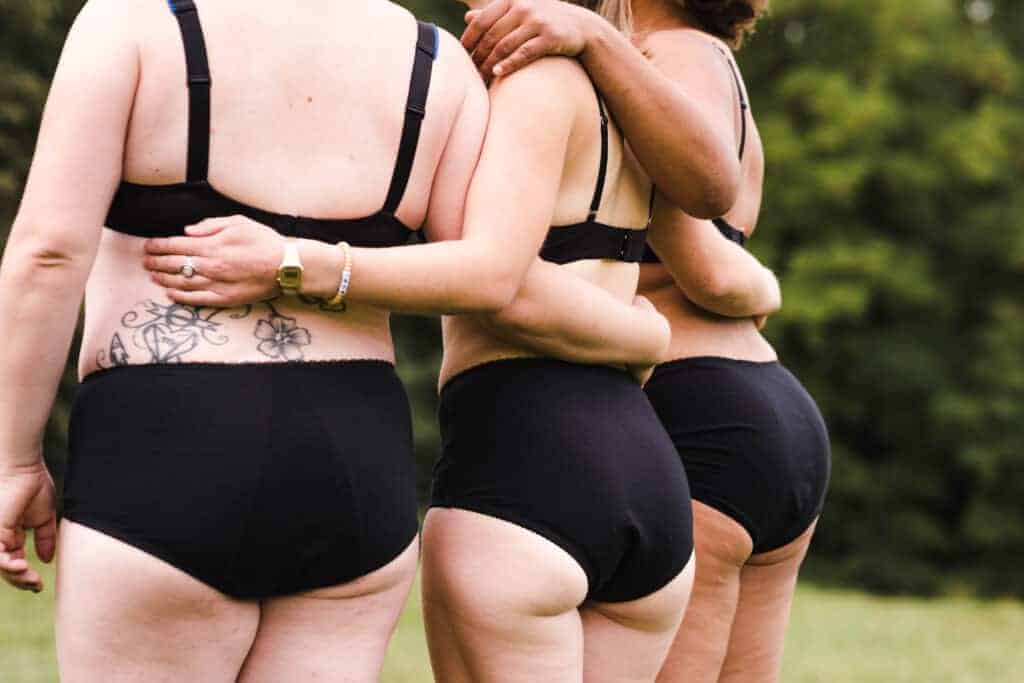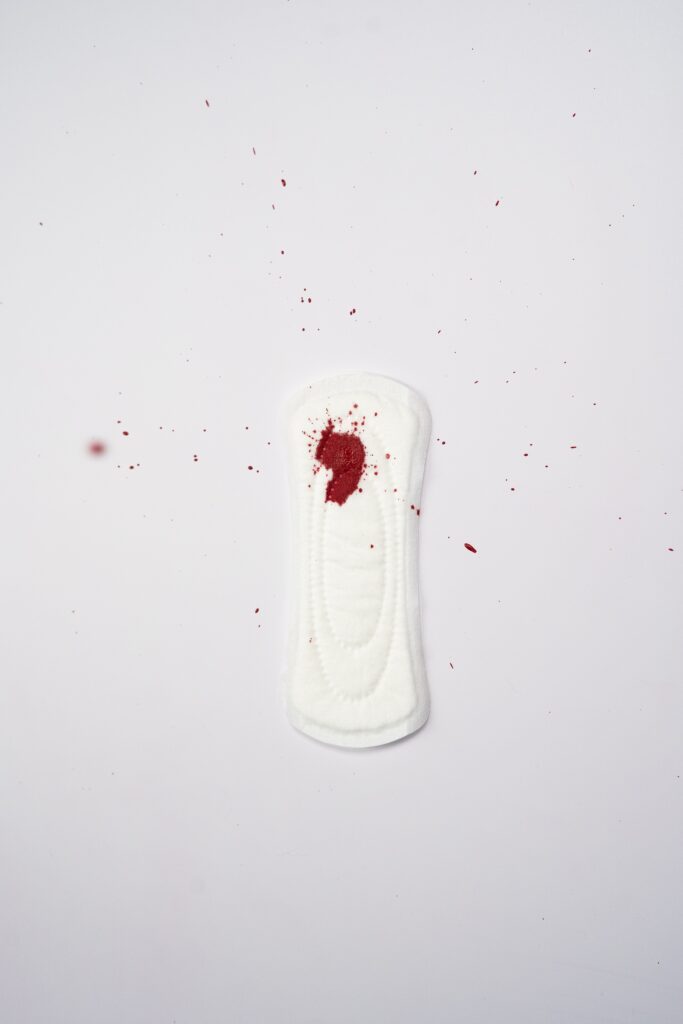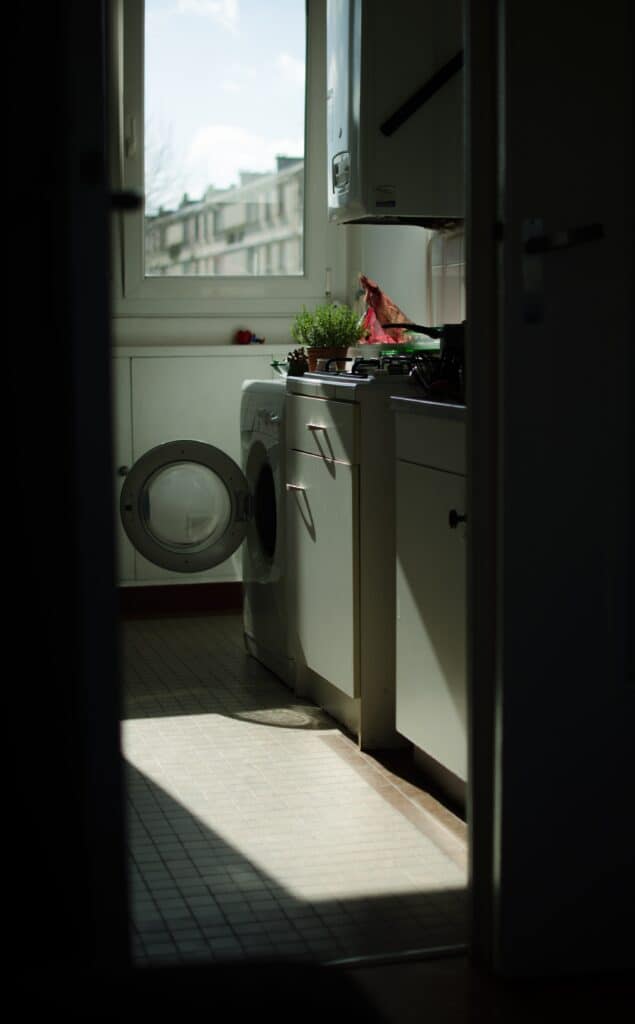A trend that originated in the USA: the period panties - also known as period and menstrual underwear or period panty - for girls and women with menstrual bleeding. But what is it really? And what are the advantages and disadvantages? How about the cleaning? Which materials are used? You can find out all these aspects about it in our big information article.


At first glance, the period panties are "normal" underpants for women. It is designed to be worn during menstrual periods to provide a cleaner and more comfortable alternative to loose pads, tampons and other hygienic items for menstrual periods. The material into which the blood is absorbed is firmly integrated in the menstrual underwear. This makes the period panty a multi-use underwear for the menstrual period with numerous advantages, although it also has disadvantages.
There are different designs or cuts. Anyone who thinks that "love killers" or grandma's knickers are to be expected here is mistaken, because they look like modern panties. You can't tell from the outside what is hidden inside. Only the mostly tight fit distinguishes them from normal everyday underwear. This is due to the elasticity that is usually present, which ensures a tight fit, so that the period panties remain impervious to all movements.
The menstrual underwear is available in different designs and types:
The period underwear has a slightly thicker crotch area due to the suction surface, which is not noticeable in good models. The rest of the briefs specially developed for menstrual bleeding cling to the body like a second skin. - provided it is a high quality model and the size is ideal. Due to the tight fit, the menstrual underwear does not slip and nothing is pressed between the labia that could pinch and disrupt wearing comfort.
For example, while bandages compress and shift through movement and blood flows next to them, the period panties remain firmly in position. The absorbent layer extends to the edges of the panties, which are cut like normal panties and completely cover the genital area. In this way, a continuously constant suction surface remains from the moment you put it on until you change it, which significantly minimizes the chance of running wrong. This has noticeable advantages, especially at night.
Menstrual underwear can absorb up to four times that of a conventional tampon. While there are no differences in supply between weak and medium-heavy periods, period briefs with extra high suction are available for heavy menstrual bleeding. A suction strength of up to six tampons can be achieved with this. However, these extra models also have a corresponding thickness of the integrated insert, which usually does not allow an almost senseless wearing comfort. Regardless of whether you have weak or heavy menstrual bleeding, the higher suction power ensures longer safety thanks to more protection.
In times of climate change and environmental protection, sustainability and resource-saving action are more important than ever. Period underwear offers a solution to avoid piles of trash, such as those caused by sanitary towels and tampons. It is washable and therefore reusable. Often they also consist of organic cotton, which grows back and thus nature is not damaged by the extraction of material.


If the timely change of panties is forgotten or is not possible for whatever reason and it bleeds through the panties, numerous manufacturers rely on dark panty colors for this. Black is therefore the most frequently offered color. Other colors are also available, so that they can be chosen to ideally match the outfit.
Although the initial purchase is significantly higher than the monthly prices of other hygiene items for menstrual bleeding, the investment pays off in the long term and is significantly cheaper in the end. High-quality period panties are often available for as little as 15 euros. For the beginning four pieces are enough, which makes a purchase price of about 60 euros. On the other hand, the reusable menstrual briefs last between two and three years on average. If you own more than four, you wear and wash them less, so that each one can last even longer. The output therefore pays off in the long term.
There is often a strong blood flow, especially at the beginning of the menstrual period and at night. Or is more blood to be expected because, for example, there is no suitable place to change your period panties on a long hiking tour? In those cases, this underwear in combination with a conventional sanitary napkin or menstrual cup offers double and longer protection.
Typically, high quality menstrual underwear has substances in the absorbent materials that eliminate odors such as those caused by menstrual bleeding and blood collection. This ensures greater well-being during your period. Odor-eliminating substances are usually not used with high-quality natural fibers and organic materials. Cleaning at higher temperatures removes odors and kills all bacteria.

The suction strength of the period panties is limited. So that the handling and the frequency of changes remain comfortable for users, it is only recommended for weak to moderate bleeding, even if there are period briefs for heavy bleeding. The safety averages between four and six hours. If there is heavy bleeding, the slip should also be combined with another hygiene item for the period to be on the safe side.
Some period underwear uses biocides to eliminate unpleasant odors and fight bacteria. Zinc pyrithione and silver chlorides are mostly used. These are criticized for being able to trigger allergies and possibly having a negative effect on fertility. This has not been scientifically proven (so far). It should be noted, however, that many manufacturers completely refrain from using biocides. So this negative aspect does not apply to all period panties.
Regular washing reduces the built-in antibacterial effect over time. The more often the menstrual underwear is washed, the faster the effect is minimized. This is due to a kind of "wear and tear" which is to be regarded as normal wear and tear and which is promoted by washing. The fibers become obsolete and increasingly lose their functions. For this reason, it makes sense to equip yourself with several period panties, so that less washing frequency ensures a longer-lasting antibacterial effect and consequently a longer shelf life.

For example, anyone who goes on long air travel or has to be satisfied with the small toilet areas in the coach will notice the inconvenience of changing panties in narrow spaces. In addition, after changing your period panties, you should pack your used panties and take them with you. Disposal is not an option here. For some women, carrying them when traveling becomes an unpleasant experience, even if an airtight transport in sealable plastic bags is not a hygienic problem. In addition, not every woman always wants to carry a spare pair of briefs with her in her handbag, which can also be easily identified as this. Creative women solve the latter inconvenience with discreet packaging. Depending on the size of the panty and the thickness of the insole, period panties can be folded down to the smallest dimensions so that they even fit in a trouser pocket.
The average prices between 20 euros and 100 euros are comparatively expensive for the purchase of the period panties if four or five panties are to be bought so that there are enough available for the duration of the menstrual period. But once bought, there are no follow-up costs and the purchase price is quickly recovered if the monthly costs for single-use products are set against it.

The use of menstrual underwear is similar to that of conventional briefs. When the period begins, the normal panties are exchanged for the period panty. Because the suction surface is firmly integrated, nothing else needs to be inserted. You only have to make sure that the slip lies on the skin without creases, especially in the crotch area, that the seams on the sides are not kinked or the like and that the slip is tight. In this way, the best possible hold and the best possible protection to prevent leakage can be achieved.
After about six hours and at the latest when the dry feeling subsides, the period panties should be exchanged for fresh ones. When the period is over, normal underwear can be put on again.
The period briefs are not only suitable for wearing during menstruation, but can also be a solution for slight incontinence. The absorbent core not only draws blood, it stores all kinds of moisture - including urine. Incontinence is not uncommon during pregnancy and even in the early stages of menopause, a disorder of the control of the sphincter muscles can lead to the loss of some urine drops. Affected women can feel more secure with period underwear.
In principle, the function of period underwear is to absorb menstrual bleeding without having to insert an extra insert.
The absorbent pad is firmly integrated in the crotch and has several layers. As a rule, the blood passes the first layer, which does not get wet and thus gives the feeling of being dry. Underneath there are further layers with an absorbent effect, antibacterial effect and absorbent properties.
Ideally, the menstrual panties sit tightly on the body and close tightly at the edges, so that a kind of tightness is created and no blood can escape.
The integrated insert of the menstrual briefs is also almost continuous from front to back, so that blood flowing towards the mattress can be collected even when lying on the back or stomach.
If the period panties are used correctly and have an ideal fit, they can be classified as very safe and consequently hygienic. It is important that a regular change is made. Here girls and women should initially orientate themselves roughly on the "useful life" of sanitary towels or tampons and slowly increase the intervals between changes to find out how much longer a period panty remains absorbent. That depends on the quality and absorbency of the panties and the strength of the menstrual period. For reasons of hygiene, the menstrual underwear should be changed after ten to twelve hours at the latest. Most manufacturers recommend six hours for heavy bleeding. For hygienic storage when traveling, it is advisable to bring lockable containers with you. In this way, used period panties are safely and hygienically packed and cannot leave any blood stains on clothing, bags or suitcases.

In order to be able to maintain the best possible standard of hygiene during the entire menstrual period, it is advisable to have at least three, or even better four, period panties per day that you can change regularly. It should be noted that with this minimum number of laundry items are required every day in order to be clean and ready to hand every day. If you have ten period panties, for example, the washing frequency is extended accordingly to every two to three days. It should also be noted that the integrated absorbent pad means that drying takes longer than with conventional underpants.
Hand washing is not recommended for many products, as rubbing could damage the fibers of the absorbent pad.
After using it, it is advisable to rinse the panties briefly under cold water. As a result, blood particles are already loosening and, in particular, larger drops do not dry out. Rubbing, rubbing and wringing should be avoided. The wet slip either goes straight into the washing machine or is hung up to drain and only cleaned later in the washing machine.

Period panties are designed to be cleaned in the washing machine. After the short wash with cold water, the washing machine at 40 degrees cleans the remaining and deeper blood particles. Some models can also be washed up to 60 degrees or even hotter. They can be washed together with other clothes without any problems.
A fabric softener should not be added to wash the panties. This can impair the function by reducing the absorbency. In addition, fabric softener can take away the elasticity of the fabric. As a result, the period panties wear out faster and lose their shape and fit. The same applies to bleach, which should also not be put in the washing machine with your period panties.
The high heat from dryers has a negative effect on the integrated insert and can reduce the elastic effect of the period panties. Therefore: Period panties do not belong in the dryer, but should be air-dried.
As a rule, the menstrual underwear comes out of the washing machine smoothly and dries without wrinkles or creases. If you still want to iron, you should definitely refrain from doing this, because as with the heat of the dryer, the heat of the iron also destroys the fiber structures of the absorbent pads and the slip fabric. It could happen that even a slight contact with the iron makes the period panties unusable or ruins their functionality. Therefore: do not iron.
Menstrual underwear is mainly made of cotton. They are also available as fair trade and organic products. Elastane is included for ideal adaptation to the body shape. Jersey fabrics made of cotton are also often offered, in which instead of a cross weave, the individual stitches are looped. This automatically gives the fabric elasticity and becomes a robust, high-quality "material".
The absorbent pad usually consists of four different materials. The top layer is made from either a fine, skin-friendly cotton or plastic fiber. The material lies like a fine net over the following layers, lets the moisture of the menstrual flow through and ensures a dry skin feeling towards the top.
The so-called absorbent core follows as the second layer. This is shown in an absorbent cotton flannel. The layer underneath forms a membrane with absorbent and antibacterial properties. In some cases this is already included in the absorbent core, so that the integrated inlay only consists of three layers. But also robust cotton period briefs that can be washed at 60 degrees, manufacturers often do without the antibacterial, odor-inhibiting layer, because these properties have to be replaced by the higher washing temperature.
Basically, however, a moisture-impermeable material always forms the end and the last layer. The materials used are mainly polyester, mostly polyurethane coating, a plastic material called "Vlieseline" or thermoplastic polyurethane. There are also manufacturers who make their own special fibers, such as those who offer period panties for vegans and therefore no animal materials can be found in them.
Period panties are one of the most comfortable alternatives for menstrual hygiene. You can find out which alternatives are still available in our overview article "Alternative monthly hygiene - what is it actually" ?
You can find many Questions & Answers in our Frequently Asked Questions (FAQ).
Unsure about the right size? See our size chart!
Click one of the items below to get started.